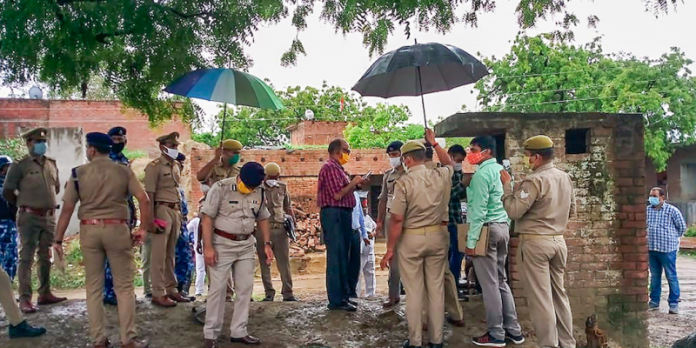The wee hours of 6th December 2019 had brought in a special ray of sunshine for all Indians, as because Disha’s murderers were shot dead by the police. The killings of the four main accused have been widely welcomed with joy across India. Hours after the encounter a large number of people started gathering at the occurrence site, distributing sweets and setting off firecrackers. There were approximately 3lakhs tweets made to support the Hyderabad police with hashtags. It has also been observed that those who were supporting the shooting described it “as an execution of suspects without fair trial” and were brutally trolled, condemned, and counter-attacked. The “wrongly trigger-happy” and “hoodlum” cops have been portrayed as “Singham” and generated a craze in popular movies challenging the extra-judicial proceedings.
After several pursuances of the human rights activists, the Sipurkar commission was set up by the Supreme court recently to substantiate this extra-judicial act. The 387 pages of detailed findings were produced by the commission which states that the encounter was fake and the accused were “deliberately gunned down”. Moreover, three were minors out of four. The commission has come up with a barrage of questions viz;
-barring cops who all were there as eye-witnesses?
– had police manuals been followed on the occurrence day?
-were there any warnings issued by the senior police officers?
-why the FIR was lodged after the encounter and tagged four of them as ‘accused’?
– what kind of injuries(minor/major) did the police personnel suffers in the brawl?
– Why has the Telangana government not initiated any judicial inquiry as mandated by law?
The police claimed that the four accused were trying to snatch the weapons and that was the only reason that all men had had to be shot. In response to the same, the commission says, no bullets or cartridges(used) were found from the site. Furthermore, the video footage of the shooting produced by the cop was incomplete. It is quite a matter of concern whether the police had arrested the right men or they just picked up the random people to balance the public outrage. At this point, the commission has recommended the 10 police personnel who were involved in this case be prosecuted. They are equally guilty of destroying and withholding the evidence. Moreover, the commission has significantly shed light on the critical aspects such as; CCTV footage, safety latches on the gun, the distance between police and accused during firing, fingerprints of the accused on the weapons, the timing of the release of the accused from the prison, time duration of the gunshot residue, Disha’s sisters claim.
It should be noted here, that the commission lacks findings related to the modus operandi of a fake counter that police usually adopt. Had it been done we would have at least known the exact motives of cops behind fake encounters. “Rapes and murders have the lowest rate of conviction” stated the National Crime Commission Bureau in the year 2021. Usually, police feel quite helpless when the conviction process takes too much time and despite the grievousness of the crime, it has been observed that the criminals are left free due to several legal drawbacks. But can we say that resorting to encounters is a solution to deal with crime rates? Obviously not, but rather police should confess more about any incident in which he is a part and stop giving peremptory justice.

There have been a lot of instances of encounters widely done by Maharashtra, Uttar Pradesh, and Punjab Police and also of killings of Naxalites and dreaded criminals in custody. We definitely have enough points to condemn the acts of these above-mentioned groups but can this be justified as one of the reasons to kill people in custody? Police custody is one such dark periphery where police exercise ultimate power. And this is the point where most of the encounters are planned. According to Markendey Katju, “these encounters are not clashes at all rather all of them are cold-blooded murders”. The Supreme Court verdict of Prakash Kadam Vs Ramprasad Viswanath Gupta observes that “ the fake encounters by the police are nothing but cold-blooded murders and those committing them must be given a death sentence, treating them in the category of rarest of rare cases”. Additionally, in 26 paragraphs of the same judgment, SC emphasizes that “Trigger happy policemen who think they can kill people in the name of encounter and get away with it should know that gallows await them”. The commission of crimes by police can only be put to an end when judicial custody from day one is provided and police should never be allowed to take custody even for some initial days. To deter fake encounters we have to change the way police act.
I shall conclude here by quoting Article 21 of the Indian Constitutes which guarantees “No person will be deprived of his life or personal liberty except with the procedure established by law. The course of justice can only be rendered by the court of law”. We have an independent and integrated judiciary in our country to deal exclusively with judicial matters. The job of the police is to carry out the investigation not to satiate the public sentiments by just doing something abruptly and haphazardly. If the police start acting like judges then who will do the work assigned to the police? Justice can only be achieved if police help the victims during grief, encourage them to trace out the suspects, and lastly corroborate the story with a competent and robust investigation.
This present report of the commission regained the faith of the people towards the impartial and rational decision-making capacity of the Supreme Court. Let the court punish all the participants in the state-sponsored murders. Moreover, each extrajudicial and every course of action of the police must be checked for prevailing justice in the country.
(The views expressed are the writer’s own.)

Dr.Bijayani Mishra is an Assistant professor in the Department of Sociology, Maitreyi College, University of Delhi. She has completed her Ph.D. from the Centre for the Study of Social Systems, Jawaharlal Nehru University, New Delhi. Bijayani specializes in the Sociology of Gender, Social Movement(s), and Penology. She has recently been chosen as a member of the Advisory Committee of the Ministry of Cooperation, Government of India.
She can be reached at: [email protected]
(Images from the net)

